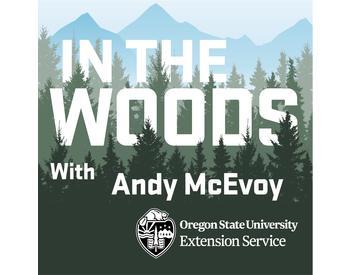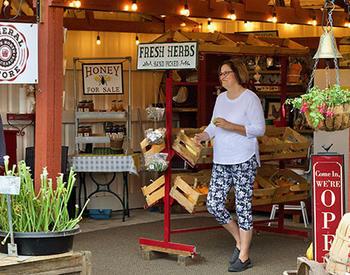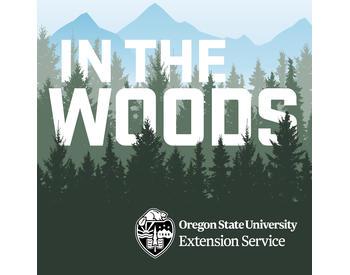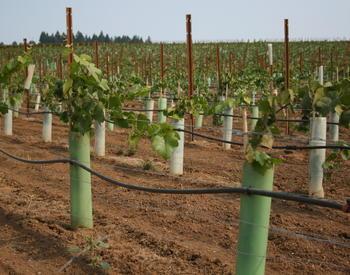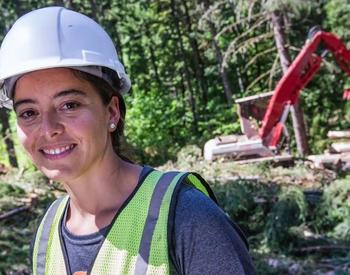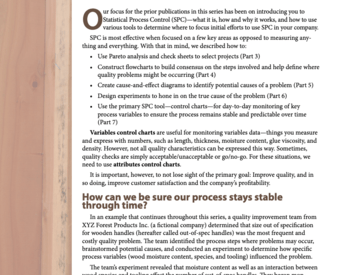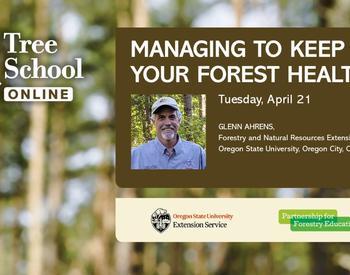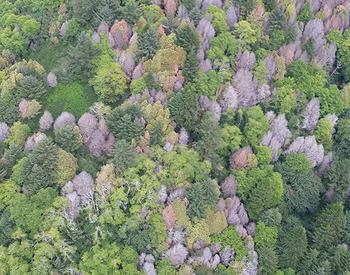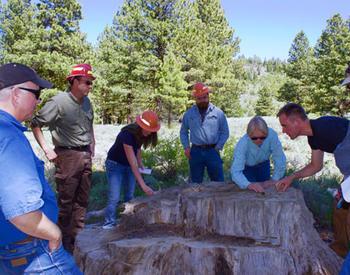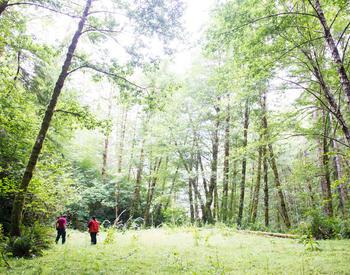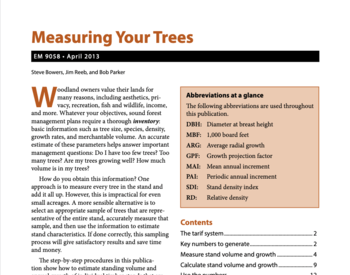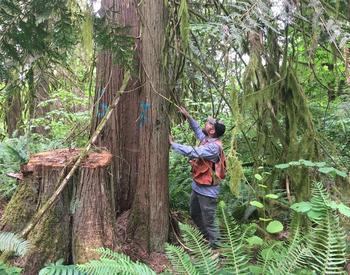Transcript
From the Oregon State University's Extension Service, you are listening to In the Woods with the Forestry and Natural Resources Program. This podcast brings the forest to listeners by sharing the stories and voices of forest scientists, land managers, and enthusiastic members of the public. Each episode, we will bring you research and science based information that aims to offer some insight into what we know and are still learning about forest science and management. Stick around to discover a new topic related to forests on each episode.
Did you know that the In the Woods podcast won an award? That's right, we've been nationally recognized by our peers as being one of the leaders in providing natural resources, content, and education through a podcast. But what do you think?
Do you like the topics we've been covering? Are there topics we're missing that you'd like us to cover? How's the quality of the episodes? We've developed a short survey where you can let us know how you feel. Head over to our website @inthewoodspodcast.org to access the survey, or you can find a link in this episode's show notes.
The survey should only take about 5 to 10 minutes for you to complete, and when you're done, you'll have the option to enter into a drawing to win some in the woods swag. We've got magnets, stickers, coffee mugs, and t shirts for you to choose from.
We really need your help, so please take a moment to fill out the survey. The feedback we receive will not only help with improving the podcast, but also help us in the Forestry and Natural Resources Extension Program to ensure we're reaching all our audiences. We look forward to bringing you more engaging content on a wide range of topics with guests from diverse backgrounds, experiences, and expertise.
From all of us at In the Woods, thanks again for listening!
Thank you for joining us on another episode of In the Woods. I'm Lauren Grand, Oregon State University Extension Forester and Associate Professor of Practice in the College of Forestry. And I'll be your host for today's episode. Today's episode is all about forest carbon.
And in today's episode, we hope to introduce you to where carbon is in the forest and what projects are available for landowners to manage with carbon in mind. I'm really lucky to be chatting with my very own colleague today, Jacob Putney. You might recognize his name. He's one of the other hosts on our podcast.
This is going to be a super fun day because we're going to get to chat, um, together, two hosts in a pod. So welcome to the podcast, Jacob. Thank you, Lauren. Uh, I think this is the first time I've been on this end of the podcast, so it's kind of weird to be, to be the, the guest I guess on, on this episode.
But, but yes. Uh, Jacob Putney. I am the, uh, extension Forester Assistant Professor of Practice for Baker and Grant Counties, and also one of your guests for this podcast. So it's really great to be here today and to talk about carbon. Thanks, Jacob. So the reason why we're having Jacob on the podcast is because he just wrangled a team of our colleagues to put together a publication on carbon and carbon projects, and so we wanted to chat with you all a little bit about the publication and a little bit more about carbon.
So, Jacob, tell me a little bit about this new carbon pub that, uh, you and our colleagues just published. Yeah, so, uh, this publication, Introduction to Forest Carbon Offsets and Markets, just came out, uh, in December, actually. But it was part of a two year project that started, gosh, in 2021, I believe. As part of our own kind of forestry and natural resource program group project process, and what was kind of a motivation was, uh, it was getting more and more questions from folks, not only in my area, but, um, hearing that there had been questions from around the state as well about, uh, forest carbon markets and the potential for some of our audiences to participate, uh, in these markets.
And I really didn't have the answers and I wasn't really familiar with them. And I realized that, at least in the Pacific Northwest at the time, we didn't really have a resource, an extension resource on the topic. And thought it would be a good idea for us to get together and put something together. So, as we kind of started through that process, um, we reached out to some colleagues at Washington State University and University of Idaho.
And a few folks, uh, were interested as well. So it kind of quickly grew into this kind of regional project that we were going to kind of put together. This introductory publication to kind of go through a lot of the basics of what forest carbon is and how forests can generate these offsets and credits and projects and things like that as a potential, uh, not only climate mitigation strategy, but, uh, a potential source of revenue as well.
So flash forward to December 2023. We finally get this publication, um, through the publishing process. And it's now a PNW extension publication that's available now. Awesome. Thanks for that history. And just for, so PNW means Pacific Northwest Publications, so it's available to all of our listeners in Oregon, Washington, and Idaho.
So let's talk a little bit about carbon, not just about this pub. And, um, maybe we should define a few terms first just to make sure we're all on the same page. So I think the biggest one that most people have questions about is what's the difference between carbon storage and carbon sequestration? Yeah, and that that's a good one.
Sometimes they're used, um, sometimes interchangeably, but they actually mean two different things. I'll backup just just a little bit. Um, when we think about trees and other plants, uh, they used carbon, usually in the form of carbon dioxide. So carbon dioxide is, um, molecular or a uh, compound, excuse me, that includes one carbon and two oxygen atoms, and it's an odorless, colorless gas in the atmosphere, and that's produced by, uh, natural processes, so fermentation or respiration, um, either by humans or animals or fungi, uh, through decomposition processes.
Um, or as a result of human activities, uh, especially burning fossil fuels. Those are the major sources of CO2 in the atmosphere. And then trees and plants use carbon dioxide as part of their photosynthesis process, where they take water nutrients from the soil, CO2 from the atmosphere, as well as, uh, light energy from the sun to produce their food, which is glucose, um, which is actually at its core, a form of carbon.
So then when we think about carbon storage and carbon sequestration, sequestration is gonna be that process where, uh, that glucose is created through photosynthesis and then stored. And then on the other hand, uh, carbon storage is then, uh, when that glucose is converted to the, the plant building structures.
So things like lignin and cellulose. So, uh, sequestration's creating the glucose and then storage is when it's converted to the plant's building structures. That was great. That's a really simple way of thinking about it. So we, you alluded a lot to, um, carbon in plants. Um, where is, let's talk a little bit more about where carbon is in the forest.
Yeah, so if we broaden it to the, to the forest level, we can think of carbon being in these different pools. Um, so we know that carbon is sequestered and stored in trees. So that's what we think about as our kind of above ground biomass pool. And so that's the things like the leaves, the branches, uh, understory vegetation, the roots or, uh, excuse me, not the roots, but things like that, all the things that are above ground on live living vegetation.
Then we have the below ground. So the things like the roots and things like that, uh, and then some smaller pools would be like the organic matter or like the litter layer on the forest floor. So all of the leaves and needles, things like that, that accumulate on the forest floor and then down woody debris.
So branches, uh, dead trees that are on the forest floor, things like that. And then, uh, about a little over half of the carbon actually in the forest system is in the soil. So stuff that's broken down, but still stored within the soil component that has not been released back to the atmosphere. Okay, so there's lots of places where we can find carbon.
So once carbon is stored in one of these things, does it stay there or does it move around? It actually, so it does move around, uh, and then the time scale at which it moves around can vary. But, uh, kind of alluded to that, uh, carbon is stored in the soil for a long time before it's eventually released back into the atmosphere.
But we can think of this system as being kind of dynamic. So we have these pools and then we can have kind of a transfer between these pools or what we call flux. And so, uh, forests and trees, you know, they, they sequester that carbon, store that carbon, uh, from the atmosphere and then it can stay there until, um, something happens usually, whether we harvest those, uh, that carbon and so harvesting can generate wood products.
So basically the carbon is still stored in those wood products, but, um, there is a component of carbon being released through the forestry activities and human activities of things like that. Or disturbance events. So you think about an insect outbreak or a wildfire. Those can, um, release carbon back into the atmosphere.
So a fire, for example, so combustion would be one of those. But also, um, as trees die through an insect or disease, for example, the, uh, decay process decomposition and the respiration from the microorganism activity can release that carbon back into the atmosphere as well. Okay, so the plants are decomposing and then the bugs that are eating them, right, breathe, sort of are respirating and breathe out CO2.
Yes, exactly. Okay, cool. So they kind of, you know. One big cycle you could think about is that carbon being released and then being stored back into the forest, but overall, uh, forests, uh, not only in the United States, but worldwide, uh, act as the Earth's largest terrestrial sink. So, a sink is a system that stores more carbon than it releases.
Of course, there is the potential that forests could be a carbon source, uh, in the event of a very large scale disturbance event. So a very large, high severity wildfire, for example, can release an immense amount of carbon back to the atmosphere, in which case forests become a carbon source, or they're releasing more carbon back to the atmosphere than they're storing.
Okay, so that's really interesting. So the type of disturbance and its intensity can, or severity, can influence, um, how much carbon is, um, released. Yes, exactly. Okay, so, now that we know that carbon moves around in our forested ecosystems, how do we sort of measure this? Like, how do we know how much carbon is there when it starts, and how much carbon is being, can we measure how much carbon is being released through various activities?
Yeah, uh, it can be difficult because there's a lot of different components, you know, I mentioned all those different pools, but carbon can be estimated. And, uh, I'll kind of try to break it down so we could think of it, uh, as kind of like a timber cruise. So we want to know how much volume, we want to know how much biomass is in our forest, and carbon we can think about similarly, where we go out and kind of systematically, we establish some plots, we measure some trees, and we do that across our area of interest, whether it be a, you know, one forest stand.
And we take those measurements and we can enter them into these equations that have been developed that gives us an estimate of the, you know, the total biomass, um, say for trees, for example. So the stem, the branches, the leaves, and things like that. And we can enter these values, uh, use them to predict how much biomass there is, and then we can, um, actually kind of convert that to carbon.
Um, so for example, the approximately 50 percent of, uh, the dry wood weight of a tree is pure carbon. So, we can basically figure out what the total biomass is, estimate how much the dry weight would be. And then take 50 percent of that and get an estimate of the carbon mass. But really what we're looking for, which we'll get into when we talk about these carbon projects, is we're looking for that CO2 equivalent.
So it's an equivalent of a certain amount of CO2 emissions, which will kind of lead into some of this carbon credit offset. Um, stuff, but, so, for example, a, uh, carbon from wood can be converted to a carbon dioxide equivalent by, uh, multiplying by 3.67. So, a molecule of CO2 is about 3.67 times heavier than a single carbon atom.
So we take that carbon mass, multiply it by 3.67 and we get that CO2 equivalent. And so for the purpose of a lot of these offsets and some of these projects, we think of these in metric tons of CO2 equivalent. Okay, so why do we care about whether it, you know, converted, it's converted into, uh, CO2, you know, where, if this is the carbon cycle and how carbon moves through the forest system, you know, why, why does it matter how, what its equivalency is in carbon dioxide?
Yeah, so in this case, the purpose of, you know, measuring these and then the potential to generate revenue from them is to use them to offset emissions primarily produced through human activities. So we want to offset them to reduce kind of our carbon footprint across the, uh, across the landscape and across the U. S. for example. So if a lot of carbon is emitted through a particular industry, and they want to, say, be carbon neutral, um, they can reduce their activities that produce carbon, or they can buy these offsets to kind of balance that, that system. So we, we use this carbon dioxide equivalent to use, um, for us as a way to, to reduce those emissions.
So we either avoid those emissions, or we, we offset them, um, we're displacing emissions somewhere else. Um, which kind of leads me to those carbon offset projects. So we're, we're, we're storing more carbon from the atmosphere with the intent of using them to, um, offset the carbon that's emitted elsewhere.
Okay, so let's dive deeper into, um, those projects you keep referring to. Um, let's talk a little bit about like what kinds of projects there are and, um, how they work. Yeah, so, um, these carbon offsets are usually generated through a carbon offset project, like I mentioned, and so for forestry, for example, there's kind of three different types of activities that remove additional carbon from the atmosphere to generate additional, uh, carbon that we use to offset, uh, emissions elsewhere.
So that's, uh, afforestation or reforestation, avoided conversion or improved forest management. Um, so afforestation or reforestation is, uh, related to restoring tree cover, um, or encouraging natural regeneration. Um, and for afforestation, it must be on land that, uh, was not previously forested for, I think, at least 50 years.
Uh, and then reforestation. It's kind of tricky, uh, cause it could be land that was not forested within that 50 years or could be subject to severe disturbance or for a certain period of time, not at what would be a, an adequate stocking level, but that could depend on a lot of different factors. Um, and then it also gets tricky because in some cases like Oregon, uh, reforestation is required by regulation.
So those in that case wouldn't qualify for that, those types of projects. Um, and then avoided conversion. Uh, these are just projects that prevent forestland from being converted to some other type of use, whether development of some type. For those, you really have to demonstrate that the forest land in this case is under a significant threat of conversion and it usually requires like a permanent easement as well.
So they will have to be permanently forested at that point and not ever able to be developed. And then the most common probably for forestry is, uh, improved forest management. So it's a intentional change in management practices that, you know, maintain and store more carbon over time. Uh, kind of beyond those that are required or what's common and what's required by law regulation, um, and kind of things like that.
Okay, so we've referred to, um, you've referred to carbon markets a couple of times. What's a carbon market? Yeah, so a carbon market is going to be the mechanism, uh, by which the carbon credits are bought and sold. Uh, so I'll back up one step. So these projects can generate offsets and then there's a kind of a process in which these offsets can become carbon credits.
So, uh, usually it's through working with a carbon project developer. And so these would be kind of like a forest consultant and kind of an organization that has their own kind of program. Uh, where they're kind of standards and protocols are approved, um, in order to help, you know, establish these projects and ultimately become carbon credits.
And those kind of go through what's called a carbon registry. So carbon registry, in this case, are kind of the, the bodies that, um, document track the generation and ownership and, uh, transaction of these credits. Uh, and they're kind of the standard setting bodies for these processes and the methodologies for projects that create these offsets.
Uh, and they kind of go through the process that the developer works through, uh, each of the different steps in the methodology for each type of project. And then they need to be verified. Um, so there's these kind of separate third party, uh, validation and verification bodies that basically look at every step of the process for each specific project, determine that the, uh, standards were adhered to, uh, each step of the methodology was, um, adhered to, they check the accuracy of the estimates for the, uh, estimate in the carbon and things like that.
And then once they sign off on them, then that kind of goes to the registry, um, and the registry is like, okay, everything looks good. Uh, then they issue the carbon credits. So then once you have those carbon credits, uh, they can be bought and sold in a carbon market. Um, so there's real two main types of types of markets within kind of this whole, uh, carbon economy, so to speak.
Uh, there's the compliance market and then there's the voluntary market. So the compliance market, uh, is regulatory. So, uh, emitters, um, must meet reduction targets for their greenhouse gas emissions. Um, so to achieve that, they can either change their practices or they can purchase offset credits. So I think cap and trade is probably the, um, the most familiar compliance market that folks might be familiar with.
And so the way that cap and trade works is that the regulatory body sets a limit or a cap on emissions that a certain industry or sector, uh, can emit essentially and, um, they're given a sort of allowance, so they can emit up to that, uh, the cap of that allowance, or if they, um, don't emit or they emit less than what their cap is, then they have this kind of allowance that then could be traded or could be bought and sold at that point.
So that's where the trade comes in. So, for example, if a business was, say, business B was emitting more than they were allowed to, more than that cap. They could either, actually let me back up, they could, uh, say business A is emitting less than their cap, and business B is emitting more than their cap. So business B has two options.
They could either purchase the unused allowance from business A, or they could purchase offsets generated through a, like, forest carbon project in this case. So that would bring them, you know, back down to what the cap is. And then, on the other hand, uh, voluntary markets are those are, they're not required by law or regulation.
Um, so basically any individual or entity or the organization, um, it gives them an opportunity to limit their emissions or reduce their emissions. Um, so this is could be motivated by, you know, sustainability or, reputation or other types of motivations and you know why they might want to reduce their emissions and these markets are a lot more flexible.
But because of that, they have a much wider range of some of the requirements and some of the things like prices and types of projects and the demand that's involved with them. Because the compliance markets are, well, required by law for some. Um, sectors or businesses, uh, the demand remains pretty consistent, and the markets end up being a lot bigger.
But on the other hand, the flexibility of the voluntary market, uh, allows for flexibility in the types of projects for, like, small woodland owners, for example. Let's talk a little bit more about getting involved in these markets. Is it pretty common for, you know, landowners to get involved? Are there lots of landowners involved in these markets or is it kind of, are there some things that we really need to think about or landowners should really think about before getting involved?
So particularly over the last five years or so, these markets have really grown, um, and we see, you know, different corporations making net zero commitments and things like that. Uh, and so we've seen these markets really evolve in terms of their just emerging and the way that their standards and methodologies are written.
However, kind of on that note for larger landowners in particular, uh, and those that can participate in, for example, the California cap and trade market, it's easier for them to participate as it is a small landowner. And I'll kind of break down why that is, um, with some of these carbon projects, there end up being some really high upfront costs.
I mean, everything from developing the project through the verification process, the inventory and quantification process, uh, the upfront costs can be pretty substantial. Uh, and so for a smaller ownership, it could be really difficult to bear those big upfront costs and kind of on that as well is having the kind of the ownership size where, uh, kind of the trade offs.
The cost and benefit of some of the trade offs really pan out as well, because thinking about how much, um, in the voluntary market, um, some of the carbon credits, I guess, sell for in this case, some of the trade offs may not be lucrative for a smaller ownership, whereas, you know, it does make sense in some cases, depending on the particular, uh, landowner's management objectives, um, it, it might.
So there's some real challenges there and a lot of programs have minimum acreages more and more we see, um, programs kind of emerging and evolving that are more targeted towards family forest landowners and smaller acreages. But really, a lot of them still have that minimum acreage of around 30 acres.
Uh, and some of the bigger programs, you know, could be upwards of, you know, 5000 or 2000 plus. Um, so it can really depend. So I think some, some real key considerations is what those upfront costs are, um, what the trade offs might be. Uh, I think it's important to note that in order for these projects, um, to be considered, it has to be, uh, you have to prove that that carbon is going to be additional.
So an intentional change in practices in order to demonstrate that that additional carbon or those, uh, that carbon benefit in this case wouldn't occur otherwise. So because I change practices, I'm therefore storing more carbon and that could be a real tricky one to prove too, um, that's a real kind of foundational principle of kind of the these carbon offsets in these these carbon credits.
And it kind of goes to ensuring the integrity, uh, and the transparency of these carbon projects that this was a, you know, planned, intentional change, stored additional carbon. So additional emissions in this case were were stored as a result. Uh, and that kind of goes back to the standards and the methodology in order in order to ensure that those are being met.
And the time commitments is another one to a lot of these contracts going back to the kind of the core principles of some of these carbon things is, uh, permanence, uh, ensuring that long-term benefit. Uh, so this isn't just a one year benefit, a two year benefit, so on, uh, a lot, in a lot of cases, these contracts range anywhere from, you know, 20 years to a hundred plus years.
Uh, and most all have a, a monitoring requirement where that, uh, not only does that carbon have to be inventoried, but it has to go back and re measured on a certain kind of interval. Um, and then there's auditing requirements in some cases too, where third party, um, verification might come in and be like, well, we need to check and make sure everything is still going as we had planned when we originally submitted this project.
Well, it sounds like there's lots of checks and balances there to make sure that. Yeah, certainly. There's a lot that goes into these. So, I want to, um, sort of clarify a little bit more about some examples, maybe offering some examples about, um, you were talking about some of the trade offs, um, in terms of putting in these projects.
It sounded like you were maybe referring to, um, thinking about harvest times and, you know, because you kept referring to, um, you know, the additional projects and the length of time and that you would be doing, really changing your involvement. So it sounds like there would be. The economic impact of changing your potential rate or amount of harvest.
Yeah. Um, so it's based off of what we call a baseline. So, um, for example, if I was a landowner and I was interested in a carbon project, one thing that they would do is, uh, is establish this baseline after kind of an inventory of my forest land of the carbon. And so they would look at me as a landowner, what type of landowner, so, uh, non industrial private forest landowner, for example.
And they would look at the geography, uh, things like distance to mill, common practices in the region. You know, there's a big suite of different things they might look at for that, that play a part in establishing that baseline, but, you know, kind of overall be, you know, where am I located? What are some common practices for my landowner type?
What are my distance to mill? Things like that. And then what am I currently doing too? So say, just for the sake of an example, you know, I typically manage, uh, Douglas fir plantations on a 50 year rotation with one intermediate thinning. Okay. So that's my kind of like business as usual scenario. So that would be my baseline in that case.
And if I needed to change my practices, intentionally change those to store additional carbon, maybe I, um, I extend my rotation period to, say, 70 years, just for example, but I still do that one intermediate thinning, but I just extend my rotation length. So that kind of delayed harvest scenario is kind of one that could be used for storing additional carbon.
So I'm growing the trees for 20 more years over what I normally would do in order to store that additional carbon in that time frame. And are there other practices that um, landowners could do that would add to or be considered, um, managing for, I guess not managing for carbon, but considered as something that's changed something more broadly, like a more broad topic. You don't have to go into a lot of detail.
Yeah, yeah. I mean, there's a number of different things that that you could do, um, depending on, you know, what forest type you're in and, um, you know, what's going to grow best and what silvicutural system might be, you know, appropriate or applicable for your particular forest type.
But, you know, um. It could be anything from, you know, switching from more of an even age plantation to managing more mixed species. Doing some more individual tree selection. Um, and really managing for forest health, uh, is a big one to, um, a healthy forest is going to be a resilient forest and thinking about those carbon release events that I kind of talked about earlier.
Uh, resistance to things like fire, insect disease is important because those are going to be events that, uh, release carbon back into the atmosphere. So ensuring the forest is healthy and resilient, um, and looking at what practices you could do to either delay harvests or, uh, change your silvicultural practices over the life of that stand to store more carbon is certainly something that would be, you know, involved as part of some of these projects.
Okay, great. Well, we know that Jake knows what he's talking about because that kind of matches what, um, uh, our guest on climate change talked a little bit about, too, with forest health and making sure that, um, we try to keep our forest healthy to be able to help out the carbon sequestration and carbon storage story in our forest.
So thanks for letting me put you on the spot a little bit today, Jacob. Um, really appreciate you talking about this new resource that we have and, um, uh, really helping to answer some big questions that lots of landowners are interested in. Um, and just people in Oregon in general about how, you know, forests play that role in the carbon cycle and the economy in terms of CO2 and greenhouse gas emissions.
So, um, really great to work with you on that project and hear more here about it today and test you a little bit. So, um, and it's really great to just be able to have the ability to share some information to people who are feeling like they want to do something. Even though it's a small part, you know, that there's something they can do and there's increasing opportunities for accessibility to smaller landowners, um, as well.
So that's kind of exciting to hear about. And you were one of the co authors for this publication. And I definitely don't feel like I'm an expert at all when it comes to a lot of these things. I think that these markets and some of, a lot of the programs that, um, are in the works and have been around for a while now continue to evolve.
Uh, and I think that there are some real opportunities for smaller landowners coming in the future, even if they aren't, you know, here right now. But, um, you know, I would just say for for small woodland owners, for example, if you're interested is, uh, you know, think about finding a good fit. You know, what questions might you have?
And do I want to make carbon a priority over some of my other objectives? Uh, do I want to make a real change from what I have currently planned already? Are those still in a line with what I want to achieve? And then finding a program, uh, or a project developer that, you know, their values really align with mine as well.
And then really consider those things that I kind of mentioned as the time commitments, what other obligations are in there, the tradeoffs, um, contracts and upfront costs and all those other things as well that which we kind of talk about within that that publication. But there's definitely a lot more that kind of go into it.
But this is a real great resource I think to get started and gave us a real excuse to learn a lot of these things as well. Yeah, that's great. And I'm glad that you brought up that there's a developer on there that there's there's organizations that are out there to help people who are really interested in making this one of their one of their management objectives.
So lots of stuff out there we'll be sure to put it on the website so speaking of our website, don't forget that the episode and all the resources we talked about today will be at our website @inthewoodspodcast.com and if you have more questions about forest carbon join us in our next episode or an upcoming episode that's really soon.
We're going to be talking to some forest researchers about new research that's come out about how to do some actual management activities that is showing increases in carbon storage on the landscape so don't miss out on that and or leave us a comment or ask us a question that you want us to feature in a future episode But don't leave us just yet.
I have the opportunity to get to now poke Jacob with the lightning round instead of another unwilling guest. So we'll be right back.
Okay, Jacob. Well, we might have asked you a couple of these questions on episode one, but we'll need a refresher from you. Or if you want to switch up your answers, we'll allow that, I guess. So what's your favorite tree? Yeah, I specifically did not go back and listen to that first episode, so, uh, I can see if my favorite tree is going to match up or if I'm gonna change it.
Cause that came out a couple years ago, I believe. Uh, I think being on the east side now for four and a half years, uh, it's still tough. Douglas fir was my favorite for a long time, but I think I might have to say western larch. Just a fascinating tree, one of few deciduous conifers, and just when it comes to fall here on the east side, it's beautiful to watch them all turn yellow across the landscape.
Yeah, I think I do remember you saying Douglas fir, so looks like the east side caught ya. That tree is getting to become more popular on the podcast, so. Okay. Um, so for you, what's the most interesting thing that you bring with you in the field, in your cruiser vest or any other field kit? Um, I don't know if it's necessarily interesting.
I was thinking about this one too. Uh, but I just got a new axe last summer and I, love, love chipping away at a tree to see what kind of insects or other critters are boring around in there. Uh, it's just always a fun one to, to show folks what, you know, these bark beetle galleries look like to see what's going on underneath the bark.
And some of these trees and trying to identify why those trees died, um, or which combination of things in most cases, but, uh, I'm very excited about this new axe that I got and, uh, being able to chop into some more trees more efficiently now. That's a handy tool. Maybe since I know you're involved in the podcast, we might make you send us a picture of you using it instead of just a generic axe for the website.
I'm used to the one taking the pictures. I'll have to see if I can't track one down of me using it. We'll find you some sort of volunteer colleague to take a picture. Okay, last but not least, it's probably one that might be a long list for this episode, maybe not. Um, but what are some resources that you'd recommend to our listeners who are interested in diving a little bit deeper into carbon markets and carbon projects?
So I mentioned that, you know, one of the motivations was there wasn't really a whole lot of resources out there, especially from kind of an extension perspective when we first started this project, but especially now, uh, there's been a number of them from across the U. S. That have really kind of emerged and really grown.
Um, and one of those that I would recommend it. The dives in a lot of stuff that I mentioned here in this publication, but really expands on it as well as continually to offer new opportunities and new resources is the forest over forest owner, climate and carbon program. It's based out of Penn State, but they have a lot of great resources to talk about this stuff as well as the forest, carbon and climate program at Michigan State University.
Make sure I get that name right. But that's another great one that they do a number of webinars pretty frequently related to a lot of these different things that would be good to check out. And then I just say, uh. Talk with your local small woodlands association, um, for things that they might be working on or other connections that they have.
I know that some programs have been talking about these carbon stuff and have some opportunities related to those. Um, and of course, working with your peers is always a great way to, to learn new information. Yeah, there are a few sort of trailblazers, um, that have been trying to work in this, get their lands certified or.
Um, involved in projects, really, I should say. And so, there's some, a few people to talk to. And I'll just confirm, you did get it right. The Michigan Forest Carbon and Climate Program was correct. Okay, good. I'm glad I didn't butcher that. I just blanked there for a second because they're, the names are so similar between those other two but, yeah, Michigan State and then, yeah, Penn State, uh, both have some good programs that they, uh, produce a lot of resources fairly frequently.
So it's always interesting to chime into some of those webinars and other resources that they're working on. Cool, well, thanks, Jacob. I really appreciate you, um, hanging out with me today and sharing this awesome information that you wrangled a bunch of cats to, um, get together.
And hopefully it acts as a good, this along with that publication acts as a good resource for people who are getting their feet wet on this topic and wanting to start to become more involved. So thanks for doing that and moving it all forward. No, thank you for helping out with it as well, and, uh, for having me on as a guest.
Like I said, it's weird to sit on this end of it. I'm used to being the one asking the questions. But it's been fun. Okay, good. Well, I'm glad I didn't torture you too much. Alright, well, this concludes another episode of In the Woods. Don't forget to join us in a couple weeks for another topic on Oregon's amazing forests.
Until then, what's in your woods?
Thank you so much for listening. Show notes with links mentioned on each episode are available on our website @inthewoodspodcast.org. We'd love to hear from you. Visit the Tell Us What You Think tab on our website to leave us a comment, suggest a guest or topic, or ask a question that can be featured in a future episode.
And give us your feedback by filling out our survey. The In the Woods Podcast is produced by Lauren Grand, Jacob Putney, Scott Leavengood, and Stephen Fitzgerald, who are all members of the Oregon State University Forestry and Natural Resources Extension team. Episodes are edited and produced by Kellan Soriano.
Music for In the Woods was composed by Jeffrey Hino, and graphic design was created by Christina Friehauf. We hope you enjoyed the episode and can't wait to talk to you again next time. Until then, what's in your woods?
In this episode, Lauren Grand invites Jacob Putney on the show to breakdown what carbon markets are and how they can be utilized to mitigate CO2 emissions.


